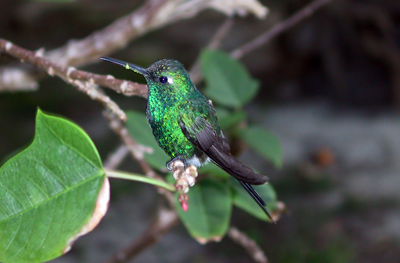CUBAN APODIFORMES - Swifts, Hummingbirds Unlike other birds that have scales or scutes on their feet, the feet of the birds in this order are bare skin with no scales. They have long primary feathers and short secondary feathers. Their young are blind, naked, and helpless at birth. Swifts have forked tails and their wings have a boomerang shape when they are outstretched. Swifts spend most of their time in the air and cannot perch because their feet are so tiny! They use their tail feathers to help them land and move around on land. Swifts have short bills and are usually dull in color. Swifts often nest in caves or on cliffs. Hummingbirds are the smallest of all bird species. They are found in North America, Central America, the Caribbean, and South America. Hummingbords have long, thin bills and a long tongue that they use to eat nectar. Hummingbirds have very tiny feet and never walk on the ground. There are only two species of hummingbird found in Cuba, the bee hummingbird and the Cuban emerald. The bee hummingbird is the smallest species of bird in the world and is only found in Cuba. It is the size of a large bee. Like other hummingbirds, the bee hummingbird can fly forwards and backwards, straight up in the air and even upside down. It can also hover in the air by moving its wings in a figure-eight pattern. The Cuban emerald is found in the Bahamas, Cuba, and the Turks and Caicos Islands. The Cuban emerald is a common bird in Cuba where it is known as the zun-zun. Males are green and feamles are green with a gray breast and belly. |
|||||||||||||||||||||||||||||||||
CUBAN APODIFORMES - Swifts, Hummingbirds
World Status Key |
Species |
Sounds |
Occurrence |
| American Black Swift -
Cypseloides niger |
Non-breeding | |
| Audio Credit: xeno-canto.org Andrew Spencer | ||
| White-collared Swift - Streptoprocne zonaris |
Year-round | |
| Audio Credit: xeno-canto.org Andrew Spencer | ||
| Antillean Palm-swift - Tachornis phoenicobia |
Year-round | |
| Audio Credit: xeno-canto.org Jesse Fagan | ||
| Bee Hummingbird - Mellisuga helenae |
Endemic | |
| Audio Credit: xeno-canto.org William Adsett | ||
| Cuban Emerald - Chlorostilbon ricordii |
Year-round | |
| Audio Credit: xeno-canto.org Jon King |
Additional Information
Key: ![]() Profile
Profile ![]() Photos
Photos ![]() Video
Video ![]() Audio
Audio
American Black Swift - Cypseloides niger ![]()
![]()
![]()
![]()
![]()
![]()
American black swifts capture insects while in flight.
Source: Seattle Audubon Society Intended Audience: General Reading Level: Middle School
American Black Swift - Cypseloides niger ![]()
![]()
![]()
![]()
![]()
The American black swift is the largest swift in the U.S. and Canada.
Source: National Audubon Society Intended Audience: General Reading Level: Middle School
White-collared Swift - Streptoprocne zonaris ![]()
![]()
![]()
![]()
![]()
![]()
The white-collared swift is found in Mexico, Central America, South America, and the Caribbean.
Source: Cornell Lab of Ornithology Intended Audience: General Reading Level: Middle School
Antillean Palm-swift - Tachornis phoenicobia ![]()
![]()
![]()
The Antillean palm-swift is found in Cuba, the Dominican Republic, Haiti, and Jamaica.
Source: Internet Bird Collection Intended Audience: General Reading Level: Middle School
Bee Hummingbird - Mellisuga helenae ![]()
![]()
![]()
The bee hummingbird is only found in Cuba.
Source: Animal Diversity Web Intended Audience: General Reading Level: Middle School
Bee Hummingbird - Mellisuga helenae ![]()
![]()
![]()
![]()
![]()
The bee hummingbird is the smallest living bird species.
Source: Arkive Intended Audience: General Reading Level: Middle School
Cuban Emerald - Chlorostilbon ricordii ![]()
![]()
![]()
![]()
![]()
![]()
The Cuban emerald is found in the Bahamas, Cuba, and the Turks and Caicos Islands.
Source: Internet Bird Collection Intended Audience: General Reading Level: Middle School

